We have recently proposed that a nanostructure consisting of two C60 buckyballs with encapsulated cobalt atoms is a nearly perfect spin filter that can be used to spin polarize electric currents. This novel nano spin filter has the advantages that, unlike conventional spin filters, it is less than 2 nanometers in size, does not require magnetic electrodes and can be turned on and off by adjusting an electrostatic gate voltage. Therefore, as well as being of fundamental interest, it may lend itself to future nanoelectronic and spintronic device applications. This work has been reported in Applied Physics Letters 102, 173101 (2013) and has been featured in Advances in Engineering. It was based in part on ideas that we had developed earlier to explain an intriguing experiment on cobalt atoms adsorbed on graphene, and have published in Phys.Rev.B85,245429(2012).
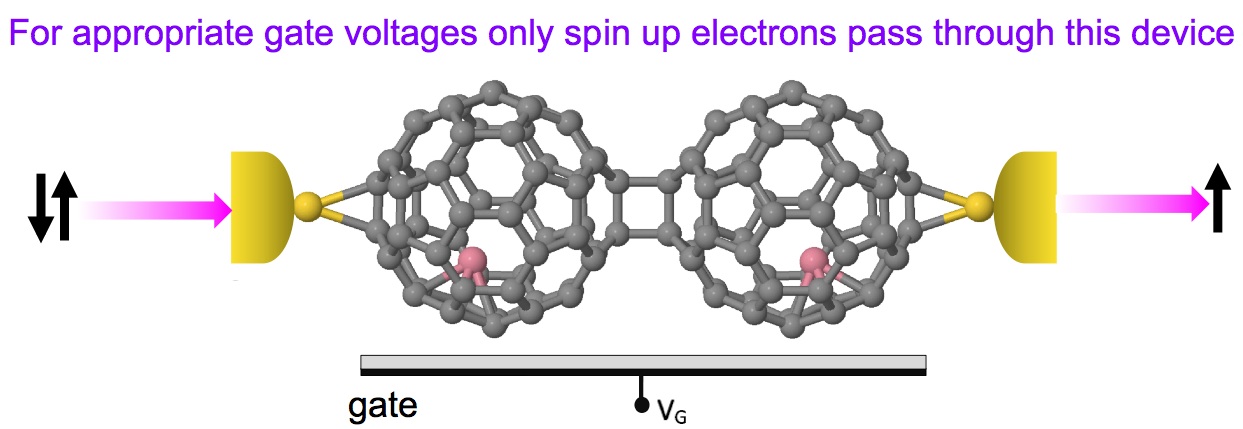
We have recently shown that the electrical resistance of a nanostructure consisting of a pair of single-molecule magnets bound to a quantum dot should change strongly when the magnetic moment of one of the molecules is reversed by the application of a magnetic field. This "spin valve" effect is due to a novel physical principle, namely, that molecular orbitals that extend over the the entire device change drastically when the magnetic moment of one of the molecules reverses, leading to a large change in the device's transport properties. This may be the explanation of the remarkably strong spin valve-like phenomenon that has been recently observed in carbon nanotubes decorated with rare earth single molecule magnets. We have published this work as a Rapid Communication in Phys.Rev.B87,121403(R)(2013). It is based on a new theoretical approach to modeling single molecule magnets and their properties that we developed and have published in Phys.Rev.B84,180408(R)(2011) and Phys.Rev.B85,245415(2012).

A molecular nanowire is a single organic molecule that bonds chemically to two metal electrodes and forms a stable electrically conducting bridge between them. The "contact problem" of molecular electronics is to determine definitively the atomic bonding geometries between the molecule and electrodes that are realzed in experiments on such devices. It has eluded solution for well over a decade, despite being critically important for understanding electrical conduction through molecular wires, and for gaining control over their structures for device applications. Recently we solved the contact problem for the first time for a molecule bound to gold electrodes via sulfur atoms by comparing the results of our first principles and semi-empirical calculations with experimental inelastic tunneling data. The journal articles reporting this work are J.Chem.Phys.134,121103(2011) (Communication), J.Chem.Phys.136,014703(2012). and J.Chem.Phys.137,094703(2012). One might expect the electrical resistance of a molecular nanowire to increase as the wire is stretched due to weakening of the chemical bonds within it. However, counterintuitively, the opposite behaviour (decreasing resistance as the wire is stretched) is sometimes also observed. Our recent work (Phys. Rev. B89, 045431 (2014)) has been able to account for this counterintuitive behavior observed for propanedithiolate molecules bridging gold electrodes.

A graphene nanoribbon is a ribbon of carbon atoms one atomic layer thick and a few nanometers wide. We explained for the first time why the conductances G of some strongly disordered graphene nanoribbons are observed experimentally to be quantized in fractional multiples of e2/h. The journal articles reporting this work are Phys.Rev.B80,201407(R)(2009) and Phys.Rev.B83,245442(2011). Our explanation of the integer conductance quantization observed experimentally in ballistic graphene nano-constrictions has appeared in Phys.Rev.B85,121407(R)(2012). Very recently we have demonstrated that, surprisingly, electron-electron interactions improve the electronic transport characteristics of graphene nanoribbons with edge defects. We have published this finding in Phys.Rev.B88,125430(2013).

An important goal in the field of spintronics is to achieve efficient injection of spin polarized electrons from a ferromagnet into a semiconductor since this is believed to be a crucial step in the development of spin-based computation and possibly also quantum information processing. We are currently collaborating with Professor Kavenagh and her group who are conducting experimental research on this topic here at SFU. Recently we have proposed a possible explanation of the remarkably high spin injection efficiencies that they have observed using electrodeposited iron contacts on gallium arsenide. This work has been reported in Semiconductor Science and Technology 28, 035003 (2013)

The possibility of combining the advantages single-molecule nanoelectronics (ultra-small size and novel properties of single-molecule devices) with those of established silicon technology is very appealing but the required basic science is only beginning to be explored. Some of our recent theoretical work on this topic (in collaboration with experimentalists Paul Piva and Bob Wolkow at U. of Alberta) has shown that electric fields emanating from molecules on a silicon surface can be used to control electrical conduction through nearby molecules and through the underlying silicon. To read an explanation of the significance of this research written for the general public click here and scroll down to the story Controlling Current on the Nanoscale. The journal articles describing this work are Phys. Rev. Lett. 101, 106801 (2008) and Phys. Rev. B. 80, 035309 (2009).

We have proposed the first theory of electrical conduction through protein fragments (called oligopeptides) immersed in electrolyte solutions and contacted with gold nano-electrodes. Our results agree remarkably well (without the use of adjustable parameters) with the magnitudes of the conductances that have been observed experimentally for these molecules. Our theory also explains the observed rectification by these molecules and predicts that under certain conditions these molecules should exhibit negative differential resistance, opening the way (in principle) to novel applications, i.e., protein-based bio-nanoelectronic devices. We have also predicted that electrochemical gating in aqueous electrolytes can transform some protein fragments from insulators into conductors, raising the possibility of bionanoelectronic switches operating in the aqueous electrolytic environments native to biological systems.

We have predicted that single molecules bridging certain dissimilar electrodes, one of which is ferromagnetic (iron is a good choice), can function as spin-current rectifiers of a novel kind: Our prediction is that the direction of the spin current passing through the molecule will not change when the bias voltage driving current through the molecule is reversed. This remarkable strong spin-current rectification phenomenon that we have predicted for the first time is yet to be observed experimentally in any molecular or other device. Due to the laws of thermodynamics it cannot have any analog in ordinary (charge) current rectification.

Another novel prediction that we have made is that certain molecules (including such seemingly simple insulators as alkanedithiolates) bridging specific combinations of transition d-metal electrodes should exhibit negative differential resistance due to the formation of molecule-metal interface states.

We are also developing a better theoretical understanding of how individual molecules carrying a electric current emit photons and phonons, and of scanning tunneling microscopy of molecules on complex substrates. We have proposed the first theoretical explanation of the experimentally observed electroluminescence emitted by individual molecules and the associated molecular current-voltage characteristics.
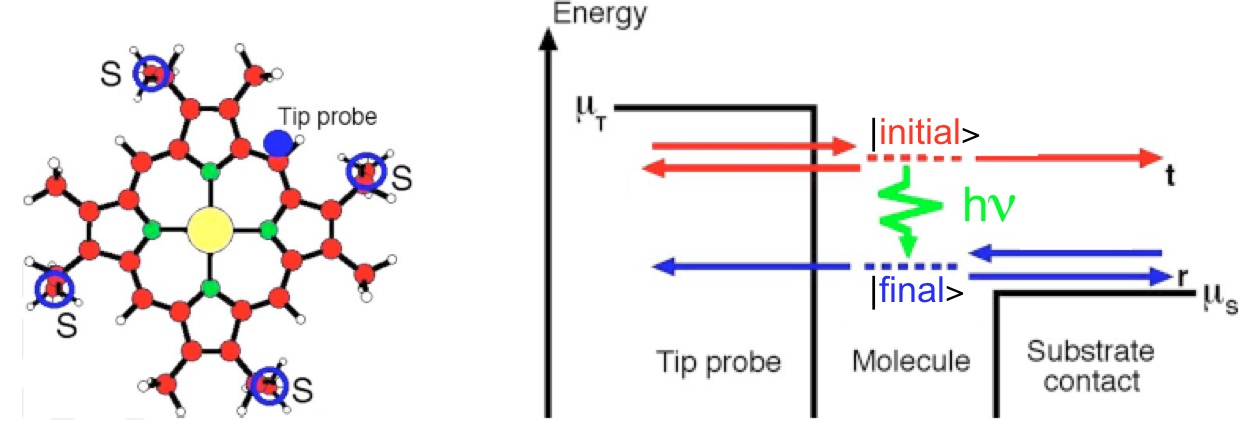
 We have also
predicted that the resistance of a benzenedithiolate
molecule bridging two gold electrodes should switch abruptly in response
to small relative movements of the two electrodes, revealing for the
first time this much studied system to be a remarkably small and
simple molecular switch.
We have also
predicted that the resistance of a benzenedithiolate
molecule bridging two gold electrodes should switch abruptly in response
to small relative movements of the two electrodes, revealing for the
first time this much studied system to be a remarkably small and
simple molecular switch.
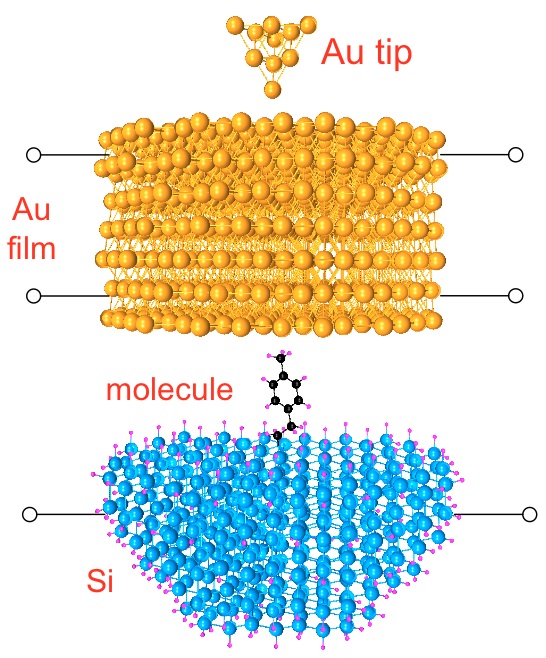 The molecules in a variety of potential future molecular
nanoelectronic devices will need to be buried to protect them from
the environment and to contact them electrically. Therefore
an ability to image and characterize buried molecules with
nanometer resolution is needed but to date this has not been
feasible. We have begun to address this issue theoretically by proposing
the first theory of ballistic electron
emission microscopy and spectroscopy of molecules on
semiconductor substrates buried under thin metal films and
predicting that these techniques should be sensitive enough
to image and characterize individual buried molecules of
certain kinds by shooting electrons at them from an STM tip
through the metal film that covers them.
The molecules in a variety of potential future molecular
nanoelectronic devices will need to be buried to protect them from
the environment and to contact them electrically. Therefore
an ability to image and characterize buried molecules with
nanometer resolution is needed but to date this has not been
feasible. We have begun to address this issue theoretically by proposing
the first theory of ballistic electron
emission microscopy and spectroscopy of molecules on
semiconductor substrates buried under thin metal films and
predicting that these techniques should be sensitive enough
to image and characterize individual buried molecules of
certain kinds by shooting electrons at them from an STM tip
through the metal film that covers them.
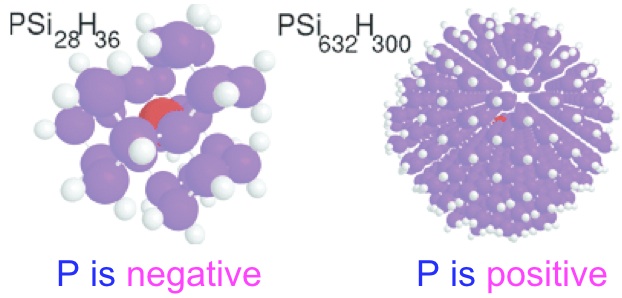 We have also
proposed that, surprisingly, the signs of the local
charges on shallow donor and acceptor impurity atoms in
silicon nanoparticles should change when the size of the
nanoparticle is reduced below a certain threshold,
signaling a transition of the nanoparticle from solid
state-like character to molecular-like character. A related
prediction that we have made is that the charge of a dangling bond on
the surface of a (mainly) hydrogen-passivated silicon
nanoparticle should depend strongly on whether a single
shallow donor or acceptor atom is present in the
nanoparticle but not on the location of this impurity atom
within the nanoparticle.
We have also
proposed that, surprisingly, the signs of the local
charges on shallow donor and acceptor impurity atoms in
silicon nanoparticles should change when the size of the
nanoparticle is reduced below a certain threshold,
signaling a transition of the nanoparticle from solid
state-like character to molecular-like character. A related
prediction that we have made is that the charge of a dangling bond on
the surface of a (mainly) hydrogen-passivated silicon
nanoparticle should depend strongly on whether a single
shallow donor or acceptor atom is present in the
nanoparticle but not on the location of this impurity atom
within the nanoparticle.
 An important problem in the area of
spintronics research is that of finding efficient ways
to inject spin-polarized electrons into semiconductors.
We have predicted that because of translational symmetry and
band structure considerations
certain interfaces between ferromagnetic
metals and semiconductors should be perfect spin
filters, transmitting electrons with a particular
spin orientation but not with the opposite one.
We have also
proposed a theory predicting novel
coherent spintronic phenomena
in ferromagnetic/semiconductor/ferromagnetic junctions.
An important problem in the area of
spintronics research is that of finding efficient ways
to inject spin-polarized electrons into semiconductors.
We have predicted that because of translational symmetry and
band structure considerations
certain interfaces between ferromagnetic
metals and semiconductors should be perfect spin
filters, transmitting electrons with a particular
spin orientation but not with the opposite one.
We have also
proposed a theory predicting novel
coherent spintronic phenomena
in ferromagnetic/semiconductor/ferromagnetic junctions.
One of the most vexing puzzles of the last decade in the field of molecular nanoelectronics was the huge (typically 2-3 orders of magnitude) discrepancy between theoretical estimates and the results of the pioneering experiment by Mark Reed and collaborators on electrical conduction through the gold-benzenedithiolate-gold molecular nanowires. We proposed the first (and to date the only) successful resolution of this discrepancy.
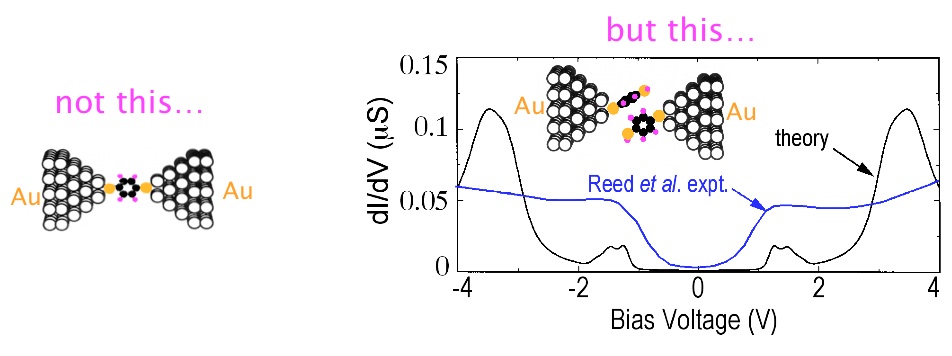
We
proposed that the transport of heat at low temperatures through
very thin nanowires
that are free enough from defect scattering to carry heat ballistically should be described
by a quantum of thermal conductance
 that is universal, i.e., it is independent of the
material of the nanowire, its length, its diameter, and even of whether
the heat is being transported by
bosons, fermions or particles obeying
fractional statistics. The universal quantum of thermal conductance
is the thermal analog of the famous electrical conductance quantum
that is universal, i.e., it is independent of the
material of the nanowire, its length, its diameter, and even of whether
the heat is being transported by
bosons, fermions or particles obeying
fractional statistics. The universal quantum of thermal conductance
is the thermal analog of the famous electrical conductance quantum
![]() .
Our prediction attracted considerable attention in the literature
and was subsequently confirmed experimentally:
The universal quantum was observed and measured
for heat carried by phonons through electrically insulating nanowires.
.
Our prediction attracted considerable attention in the literature
and was subsequently confirmed experimentally:
The universal quantum was observed and measured
for heat carried by phonons through electrically insulating nanowires.
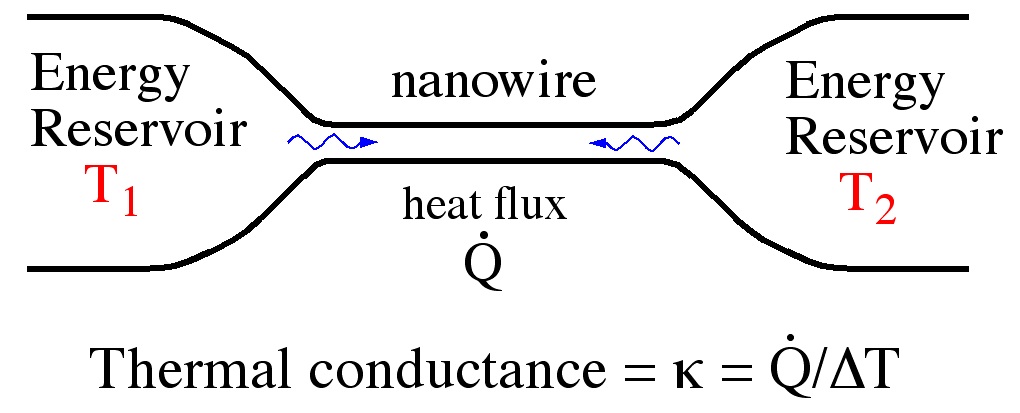
Our most recent contribution to the study of the quantum Hall effects and related nanoscale and mesoscopic phenomena has been to explain several puzzling phenomena that had been observed experimentally in 2-dimensional electron gases in the quantum Hall regime separated by a lateral tunnel barrier in terms of the theory of directed localization and "quantum railroads".
We have also investigated the properties of metal nanoparticles, specifically with regard to the microscopic origin of features observed in their tunneling spectra and the nature and kinetics of the many-particle excitations created in them by successive tunneling events.
The above are just a few recent examples. We have also studied a wide range other problems in nanoscale and mesoscopic physics and condensed matter physics.